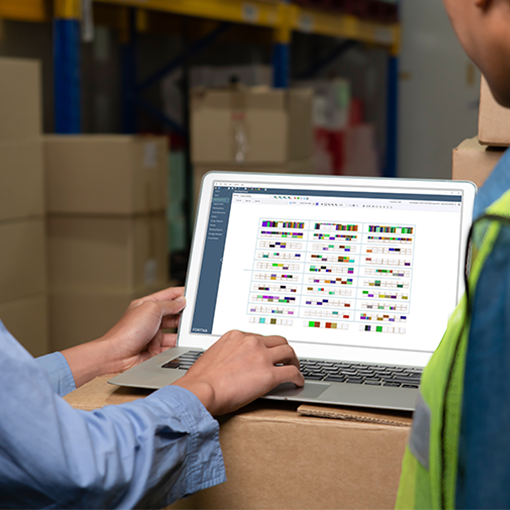Due to the corona pandemic, logistics has to master its greatest challenges. Innovative technology from DENSO Wave Europe makes logistics processes leaner, faster and more efficient.
Logistics is under massive pressure: On the one hand, the industry has good growth prospects due to the corona-related growth in e-commerce. On the other hand, however, it has to meet increased customer demands and at the same time master the digitalisation.
The current study “Mobilising the Delivery Workforce: The State of Mobile Technologies in Transport and Logistics 2021” by Arlington Research shows that mobile-first technologies will play a key role in the delivery of goods in the final delivery area. 70% of those questioned are of this opinion. Almost half of the respondents also stated that technologies for implementing the mobile-first strategy will play the most important role in accelerating delivery processes.
DENSO Wave Europe, part of the Toyota Group, knows the challenges in logistics and the competitive pressure, which is increased by globalisation but also the call for more digitalisation. In logistics, it is also important to transport goods safely and just-in-time over ever longer distances.
“Transparent processes show potential for optimisation in logistics,” says Dirk Gelbrich, General Manager Technical Department at DENSO Wave Europe. “The Auto-ID solutions, handheld terminals and scanners as well as wearables from DENSO record data from picking to delivery. In this way, they provide essential information within the supply chain in order to make processes comprehensible and measurable,” he explains.
RFID technology also plays a key role in the digitalisation of the logistics industry. RFID ensures that processes along the supply chain become leaner, faster, and more efficient. Information on how DENSO Wave Europe can contribute to overcoming current and future challenges in logistics with its handheld terminals, scanners, wearables, RFID readers, and Auto-ID solutions, can be found here: https://www.denso-wave.eu/en/industries/transport-logistics.html
Logistics benefit from RFID devices and IoT solutions
In the future, it will become more and more important to accelerate delivery processes. In the above-mentioned study, 40% of the respondents said they want to invest in technology that accelerates deliveries. RFID readers are ideally suited for these projects as they help logisticians accelerate their processes and work more efficiently.
The RFID scanners from DENSO Wave Europe offer outstanding reading speed and robustness – a decisive advantage for logistics, but also for warehouse management and transport.
“With RFID, processes along the supply chain can be optimised. Additionally, inventory surpluses and shortages in the warehouse can be avoided with RFID and the appropriate mobile data collection devices. If logisticians can record accurate inventory data along their supply chain, a basic problem has already been solved and further optimisations to accelerate the processes can follow,” says Gelbrich, explaining the advantages of RFID when digitalising logistics.
The UR40 RFID reader from DENSO, for example, can read 700 RFID tags per second. This makes the RFID reader one of the fastest in the industry.
Another result of the study is that 80% of the transport and logistics companies surveyed are planning significant investments in technologies such as mobile devices, wearables or IoT devices and IoT solutions.
DENSO Wave Europe is also very well positioned in the field of IoT solutions and, with the ORiN IoT data management platform, offers an ideal tool for logistics and transport companies. “Practically speaking, it is not that simple to create a data-networked environment in a company,” says Gelbrich. For a smart factory, however, the technology to connect devices within the facility and to collect data from these devices for analysis purposes is essential.
“DENSO offers ORiN as the best solution. It is our IoT data management platform, which provides a middleware with which information from various automation devices can be collected more efficiently. The data can then be shared with other systems and cloud solutions,” says Gelbrich. Data can be freely forwarded and transformed between all connected devices and software systems and further steps can be planned accordingly.
ORiN can be used, for example, in the production sector for process optimisation, condition monitoring, and production control. Collected data can be viewed using built-in data analysis and display tools. “The logisticians are faced with the great challenge of having to make their own company processes faster and more efficient – a huge long-term task. But it can be mastered with DENSO Wave Europe, RFID, and innovative IoT solutions,” summarises Gelbrich.
Further information on the RFID scanners and IoT solutions from DENSO Wave Europe, and how companies can optimise processes in logistics, transport, and warehouse management, is available HERE.
For the European market, DENSO Wave Europe is the contact point for all enquiries on RFID, QR Codes, mobile data collection, handheld terminals, and scanners. The durable and robust terminals and scanners manufactured by DENSO are to be found in storage, logistics, at the POS, in production, and field & sales automation applications.
Short and informative video clips about the terminals, scanners, and solutions from DENSO Wave Europe can now be viewed on YouTube. The clips include the 20th anniversary of the QR Code, a company presentation, and introductions to the various devices for mobile data capture such as the BHT-1500, BHT-1400 and the GT20 scanner.









